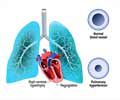Prevention of Deep Vein Thrombosis (DVT)
Mechanical or pharmacologic methods are available for prevention (prophylaxis) of DVT. The use of sequential compression devices (Compression stockings) is the most common method of prophylaxis.
A patient who has undergone either major abdominal surgery or major orthopaedic surgery or has sustained major trauma, or has prolonged immobility (>3 days) is at a high risk of developing DVT.
Mechanical or pharmacologic methods are available for prevention (prophylaxis). The simplest method is early ambulation after surgery. A patient who is expected to be up and walking within 24 to 48 hours of a surgery or trauma is at a low risk of DVT. Sitting in a chair with the legs in a dependent position causes venous pooling. This shouldn’t be advocated in patients after surgery.
Long flights can also lead to DVT. Hence during flights airlines encourage you to keep exercising your legs and take a small walk once in a while. If you are prone to swelling of the legs, you are likely to be more prone to DVT. In such situations you should wear stockings that would help your circulation. These stockings are called 'Compression Stockings'. The use of sequential compression devices (Compression stockings) is the most common method of prophylaxis. It should be used before the patient is shifted to the operation theatre for any major surgery.
Recent literatures support the use of fractionated low-molecular-weight heparin (LMWH) for prophylaxis and treatment of venous thrombo-embolism.

















